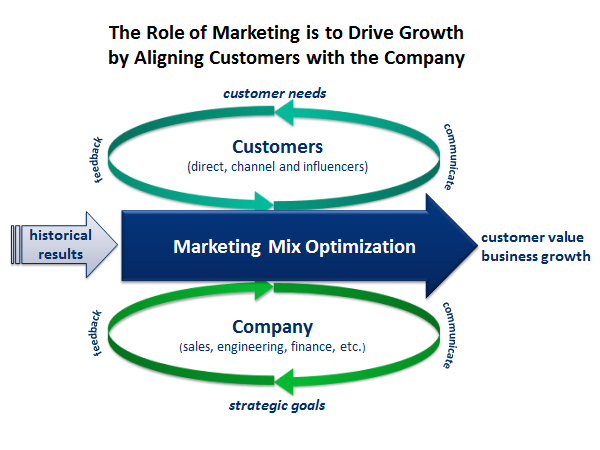The post Marketing Management Tactics for Quelling Public Unrest appeared first on Markodojo - Marketing Management Software - Agile Marketing.
]]>In this not-so-tongue-and-cheek blog series, we present 18 Marketing Management Survival Tactics for staving off common marketing management disasters. The first two posts in the series provided 12 tips for surviving marketing management natural disasters and man-made marketing management industrial accidents. This third post in the series provides 6 proven tactics for quelling public unrest.

Marketing managers have many choices. In particular, marketing managers must decide what they are going to do before they can plan how to do it. Should you improve your message or drive more traffic? Does your product need more capability or higher quality? Once decided, the real work begins. Without a clear strategy, each marketing manager chooses differently and you end up with marketing anarchy characterized by conflicting priorities, confusion, frustration and inconsistent, sub-optimal marketing results.
Your marketing strategy must be more than a plan. It should include clear cross-functional goals and priorities that facilitate everyday decisions by constraining marketing choices and clarifying marketing tradeoffs. You can’t just do a presentation or send out a memo. Marketing strategy must be baked into your marketing management process to link everyday work to strategic initiatives, keeping work in step with strategy even when priorities change. It should enable every marketing manager to make coherent choices and avoid wasting time on random acts of marketing.
Marketing Management Survival Tactic #13
Improve alignment and integration by linking campaigns and projects to strategy. Publish a real-time marketing roadmap that presents your marketing plan by strategic initiatives, such as “increase awareness”, “drive new business” and “build loyalty”.
Marketing Management Survival Tactic #14
Task lists are great for getting things done, but they don’t help you decide if you are doing the right things in the first place. Don’t just make a list of marketing projects. Create roadmaps, calendars, campaign plans and charts by market segment, channel, product, buyer personae, strategic initiative, customer value, and other critical marketing dimensions to see if your marketing work and results are properly balanced, prioritized and integrated.

Everybody wants something from marketing. Sales wants leads. Support wants a community website. The CFO wants more revenue with less budget. And, every CEO has a pet marketing project. Keeping stakeholders happy, particularly when they have conflicting priorities, is a never ending challenge of every marketing department. If you consistently miss stakeholder expectations, you’ll find yourself facing a frustrated and angry mob.
You can’t please all of the people all of the time, but you can build buy-in and co-opt your critics. The best approach to quashing marketing stakeholder problems is to involve stakeholders in the solution. First and foremost, keep stakeholders apprised of marketing plans and performance. Marketing blackouts encourage stakeholder riots. Proactively solicit feedback on marketing plans and source suggestions for future marketing programs. Collaborate directly on important marketing projects, so your stakeholders are as committed to success and own the results as much as you.
Marketing Management Survival Tactic #15
The best way to avoid angry mobs is to set the right expectations in the first place. Communicate key marketing strategies, priorities, plans and decisions broadly to all interested stakeholders on a regular basis.
If you like these marketing management survival tactics,
then check out the complete Marketing Manager’s Survival Kit and get all 18 tactics.
Marketing Management Survival Tactic #16
People tend to take care of their own. If you want real stakeholder buy-in to your marketing plans, then you should include them in your planning process. In fact, you should collaborate with stakeholders on the actual work to tap into their ideas and perspectives. When you co-opt your critics, they don’t just buy into your plans, they co-own the results.

Rapid organizational changes can wreak havoc on marketing productivity. High growth, corporate reorganizations, acquisitions and sudden turnover can create scenarios where the marketing department is full of new, inexperienced and potentially unmotivated marketing managers. Even the most senior marketing managers can freeze up while coming up to speed on entirely new surroundings. Welcome to the marketing zombie apocalypse, where the blind lead the blind and nothing gets done except trying to keep yourself from being eaten alive.
When ramping new or inexperienced marketing team members, it’s best to be more explicit about what, when and where things need to get done. While experienced, senior marketing managers are proficient team leaders, more junior team members need to be led. They are also less likely to raise the alarm when they are stuck or overloaded, and have no internal benchmark for good performance. Priorities and tasks should not only be explicit, they should be visible to the entire team, so marketing managers can detect and resolve individual problems before they impact other team members and marketing deliverables.
Marketing Management Survival Tactic #17
It’s hard to tell if you are doing great if you don’t know what great looks like. When everyone has a clear picture of superior marketing performance, then it easy to tell when marketing managers are living up to their true marketing potential.
Marketing Management Survival Tactic #18
When tackling an entirely unfamiliar project, even the most experienced marketing managers appreciate a little detailed instruction. Also, unmotivated and underperforming staff need to realize that they are bringing down the entire team. The best way to handle both of these difficult marketing management situations is to define specific task plans and monitor progress until the suffering individuals are back up to top performance.
The post Marketing Management Tactics for Quelling Public Unrest appeared first on Markodojo - Marketing Management Software - Agile Marketing.
]]>The post Avoiding Marketing Management Industrial Accidents appeared first on Markodojo - Marketing Management Software - Agile Marketing.
]]>In this not-so-tongue-and-cheek blog series, we present 18 Marketing Management Survival Tactics for staving off common marketing management disasters. The first post explored how to survive marketing management natural disasters. This second post in the series provides 6 proven tactics for avoiding common man-made marketing management accidents.

If no one knows what marketing is doing, then the natural conclusion is that marketing isn’t doing anything terribly important. Moreover, when different groups within the marketing organization don’t know what other groups are doing, it is impossible to provide a unified experience for your customers. Unfortunately, most marketing plans, projects and performance reports are hidden away in spreadsheets, documents, email inboxes and other poorly lit locations.
Ending a marketing blackout requires systematic collection, integration and publication of marketing plans, projects and performance. Current marketing plans, status of work-in-process and marketing performance reports for each marketing area should be available to everyone in the marketing department. High level roadmaps, monthly marketing calendars, and regular updates should be published to all marketing stakeholders. Without an integrated marketing management system, consolidating and communicating marketing activities is pure overhead and can be quite labor intensive. However, the alternative marketing blackout is far worse.
Marketing Management Survival Tactic #7
Real-time visibility across the entire marketing department requires detailed project tracking. Consider implementing a marketing project management system. A rigorous and automated approach to marketing project management increases the probability that reality mirrors your marketing plan, and eliminates busy work. If you systematically collect information at the project level, then higher-level views, such as marketing roadmaps, calendars and progress reports can be completely automated.
Marketing Management Survival Tactic #8
An easy way to keep everyone informed about upcoming marketing promotions, projects, and events is to publish a monthly marketing calendar and update it weekly. Share the marketing calendar with marketing, sales, other departments and the executive team to keep everyone informed.

Sometimes big problems come in small, well-intentioned packages. For example, when the VP of Sales makes a simple and reasonable request that threatens to blow up all your well-thought-out marketing plans and committed marketing goals. Can we upgrade the website next month? Let’s start doing webinars once a week. And, so forth. Then there are the super urgent, yet conflicting requests. The VP of sales wants a website upgrade, but the VP of customer success wants a community portal, and, you only have one web team.
The ability to defuse potentially volatile situations involving hard-charging, single-minded executives is an essential marketing manager skill. Life is easier, however, if skill is also supported by process and a few facts. Executives ask marketing for things they think they need to be successful. However, exactly what they need and when they need it allows room for negotiation. What is the priority of the request relative to projects on the current marketing roadmap? Does it all need to be done yesterday, or can it be broken up into smaller projects and rolled out over time? Or frankly, is it sufficient to just capture the idea for future consideration.
Marketing Management Survival Tactic #9
The secret deactivation code to defuse every explosive executive situation is the word “YES”. Manage project scope, not just resources. By breaking big project requests up into smaller increments, you can provide immediate satisfaction without derailing current marketing plans. Say “YES” to something small today, and deliver the bigger vision incrementally over time.
If you like these marketing management survival tactics,
then check out the complete Marketing Manager’s Survival Kit and get all 18 tactics.
Marketing Management Survival Tactic #10
An executive request that looks important and easy in isolation, might be foolish and difficult when weighed against current marketing plans. Everyone wants marketing to work on the most valuable ideas, so keep a prioritized backlog of all potential marketing projects and publish it for stakeholders to see. Build consensus around your marketing plan and backlog priorities. Now handling a new request is just an exercise in reordering the backlog.

Most marketing departments are under-resourced and over-committed. There is no time for do-overs. Fuzzy objectives, fuzzy assignments, fuzzy agendas, fuzzy hand-offs and fuzzy communications lead to endless marketing rework and countless hours spent in useless staff meetings. Busy work that eats up precious marketing cycles without moving things forward is a toxic waste of time that can seriously undermine marketing performance.
Cleaning up waste from rework requires clearing up day-to-day marketing management activities. Luckily, it doesn’t require a lot of overhead. Rigorous work habits and simple process rules will often do the trick. Make sure strategic marketing goals are clear, so you don’t waste time on unimportant projects. Don’t start a new marketing project without clear objectives and requirements. Create modest project plans with a special focus on deliverable hand-offs to coordinate cross-functional teams. Make sure every project and deliverable has a single, clear owner. Bring an agenda to every meeting and record issues, decisions, and action items.
Marketing Management Survival Tactic #11
Email, chat, and social tools are great for one-off conversations, but they lack the context, depth and continuity required for purposeful collaboration. Consider a marketing collaboration platform that links conversations, documents, and decisions directly to projects for greater efficiency.
Marketing Management Survival Tactic #12
Streamline team meetings by eliminating updates on work that is going according to plan—just make sure the plan is up-to-date before the meeting. Focus instead on coordinating hand-offs, resolving issues, helping stuck team members, and removing obstacles from blocked projects.
The post Avoiding Marketing Management Industrial Accidents appeared first on Markodojo - Marketing Management Software - Agile Marketing.
]]>The post Surviving Marketing Management Natural Disasters appeared first on Markodojo - Marketing Management Software - Agile Marketing.
]]>In this not-so-tongue-and-cheek blog series, we present 18 Marketing Management Survival Tactics for staving off common marketing management disasters. This first post in the series provides 6 proven tactics for surviving marketing management natural disasters.

Creating demand and driving sustainable revenue growth is the primary charter of every marketing organization. However, they are much easier said than done. There are times when increasing demand is as simple as ramping advertising spend. Sooner or later though, every ad campaign and media channel runs dry. Ending a demand drought requires marketing innovation, and marketing innovation requires the ingenuity of skilled marketing managers.
The problem is ingenuity doesn’t scale. Sustainable revenue growth cannot rest entirely on the shoulders of a few creative marketing managers. To prevent recurring demand droughts, you must systematize marketing innovation. New marketing ideas, both big and small, must be sourced, brainstormed, prioritized, tested, measured and assessed on a regular basis. Successful new ideas then become ongoing marketing programs, and innovation shifts to marketing program optimization. If you want to be a revenue rainmaker, you must build a marketing innovation machine.
Marketing Management Survival Tactic #1
Source new marketing ideas broadly and routinely by conducting regular surveys of customers and sales, publishing request and feedback forms, and soliciting suggestions from throughout the entire company. The wider the net you cast, the better your chances of catching that next great marketing campaign idea.
Marketing Management Survival Tactic #2
Create a running backlog of all marketing ideas that you can draw on at any time. Set a standard for prioritizing ideas based on relative value and level of effort required to implement them. Groom the backlog on a regular basis to refine good ideas, remove outdated ideas and reprioritize those that remain. By keeping a running idea backlog, you simplify marketing planning and make sure you never lose a good revenue generating idea.

To capture the attention of busy buyers, marketing managers plan global campaigns, product launches, seasonal promotions, and spectacular events that routinely fill marketing departments up with a deluge of work. If you don’t brace yourself for these foreseeable floods, quality will suffer and marketing teams will drown in a sea of work. Marketing management at scale is a process, not a project, and marketing managers must master important process management principles to open the floodgates when the tide runs high.
If you like these marketing management survival tactics,
then check out the complete Marketing Manager’s Survival Kit and get all 18 tactics.
Handling a deluge of work with limited marketing resources requires scalable, efficient marketing production processes based on increased standardization, automation and quality. The more your marketing production processes resemble a factory, the more marketing output you can generate per marketing team member. Most marketing projects from websites to trade shows require the coordination of cross-functional marketing teams. While these people-centric processes cannot be fully automated in the same sense as sending an email, their production capacity can be dramatically increased by implementing a marketing project management system with standardized workflows, formalized hand-offs, deliverable templates, reusable assets and proactive management of resource bottlenecks. Once standardized, routine tasks can be automated and end-to-end processes can be optimized through continuous improvement.
Marketing Management Survival Tactic #3
Increase the efficiency of people-centric marketing processes by focusing on the handoffs. Define specific process stages, such as draft, copy, design, proof, etc. and create outlines and templates for deliverables that get handed-off at each stage. Track marketing projects by stage to ensure a smooth work flow. Just like you do with the purchase funnel!
Marketing Management Survival Tactic #4
If you monitor marketing projects by workflow stage, then you can identify bottlenecks in your marketing management process when a particular stage backs up. Bottlenecks in any stage reduce the output of the entire process. Remove bottlenecks to keep your marketing projects flowing and increase efficiency.

Budget cuts, competitor moves, PR crises: sometimes unexpected bolts from the blue shock a well-organized marketing plan into complete disarray. When things change rapidly, does your marketing organization absorb the shock and rebound nimbly? Or, does it end up in a panic that puts everything else on hold until the crisis passes? Insulating your marketing organization against sudden shocks requires a flexible marketing management process that expects change and adapts quickly.
If you find it difficult to plan because you are constantly dealing with unforeseen changes, then you should consider adopting agile marketing best practices, such as working incrementally. When you know your marketing plan will change each month, then you should not commit to projects that will take longer than a month to implement. Break big projects up into smaller ones that fit into your known time horizon. Don’t make rigid plans that extend out several quarters. Set long term goals and prioritize your backlog of projects accordingly. Focus on producing a steady stream of work based on your backlog. When lightning strikes, you just have to adjust your priorities, not your plans.
Marketing Management Survival Tactic #5
Big projects reduce flexibility, while small projects increase it. Implement big projects incrementally by breaking them up into smaller ones. When lightning strikes, you can easily shift to something else without lowering productivity.
Marketing Management Survival Tactic #6
Once you start working incrementally, you can fit projects neatly into weekly, bi-weekly or monthly work ‘sprints’. Each sprint cycle, you strive to complete projects assigned to the current sprint, then realign priorities for any changes as you plan the next sprint. Sprints increase your flexibility, strengthen your focus on tangible results, and establish a regular heartbeat within your marketing organization.
The post Surviving Marketing Management Natural Disasters appeared first on Markodojo - Marketing Management Software - Agile Marketing.
]]>The post Marketing Teams that Drive Growth | Ebook appeared first on Markodojo - Marketing Management Software - Agile Marketing.
]]>Markodojo Marketing Management Process Series
Marketing teams come in many varieties and they employ an even broader variety of marketing programs. In the end, however, all marketing managers are tasked with the same goal: deliver customer value that drives revenue growth. There are countless great marketing blogs, e-books and indeed textbooks on tools and techniques to drive revenue growth: once. Unfortunately, you don’t create sustainable revenue growth by stringing together a hodge-podge of marketing programs. Sustainable revenue growth requires a marketing management process that empowers marketing teams to discover, optimize and scale new sources of revenue, again and again.
Sustainable revenue growth requires innovation to optimize new marketing programs and high production efficiency to scale mature ones. However, the skills, org structures, and processes that foster program innovation are often in direct opposition to those that increase production efficiency. Efficiency without innovation results in flat-lined revenue as existing marketing programs run out of gas. Innovation without efficiency results in low marketing ROI and un-scalable random acts of marketing. This new Ebook helps aims to help you achieve the right balance for your marketing organization by deploying marketing teams that fit your specific challenges and drive sustainable growth.
The post Marketing Teams that Drive Growth | Ebook appeared first on Markodojo - Marketing Management Software - Agile Marketing.
]]>The post 7 Marketing Management Lessons You Don’t Learn in B-School appeared first on Markodojo - Marketing Management Software - Agile Marketing.
]]> Most major business schools offer degrees in marketing management. These programs teach aspiring marketing managers all the fundamentals of marketing, unfortunately they teach very little about marketing management. Unless you expect to spend your entire marketing career as a department of one, then there are some very important marketing management lessons you probably missed in business school.
Most major business schools offer degrees in marketing management. These programs teach aspiring marketing managers all the fundamentals of marketing, unfortunately they teach very little about marketing management. Unless you expect to spend your entire marketing career as a department of one, then there are some very important marketing management lessons you probably missed in business school.
This is the last post in a Markodojo marketing management blog series on marketing management process. Earlier posts in the series focused on common marketing management pitfalls, the importance of marketing leverage in driving sustainable revenue growth and organizational options for scaling marketing teams. This final post provides a leg up for marketing managers that want to accelerate their careers with seven marketing management lessons that usually take many years of experience to learn.
Marketing Management Lesson #1
 The fundamental goal of marketing is to drive revenue growth by increasing customer value. Every single job in marketing contributes to this goal. If it does not, then the job should not exist in marketing. As a marketing manager, you are by definition accountable for revenue, so you should always act like it. If you are a marketing manager at a non-profit, then you can take the equivalent stand of being accountable for customer value. Every decision you make should be examined from the perspective of customer value and revenue impact. Every budget line item you propose should contribute to this goal. And, don’t shy away from revenue-based compensation; it demonstrates your accountability.
The fundamental goal of marketing is to drive revenue growth by increasing customer value. Every single job in marketing contributes to this goal. If it does not, then the job should not exist in marketing. As a marketing manager, you are by definition accountable for revenue, so you should always act like it. If you are a marketing manager at a non-profit, then you can take the equivalent stand of being accountable for customer value. Every decision you make should be examined from the perspective of customer value and revenue impact. Every budget line item you propose should contribute to this goal. And, don’t shy away from revenue-based compensation; it demonstrates your accountability.
Marketing Management Lesson #2
 Business schools teach that marketing provides leadership grounded in a deep understanding of customers. In the real world, marketing is an isolated corporate function that can easily lose touch with the customers it serves. Whether you are crafting a new message, building a better product or justifying your marketing budget to the CEO, your credibility always comes from the customer. The more you can back your opinions and your numbers with customer opinions and customer numbers, the more compelling your business case. The corollary to this lesson is that you should include your customers in every stage of the marketing management process: generating new marketing ideas, collaborating on marketing programs, and providing feedback on marketing results.
Business schools teach that marketing provides leadership grounded in a deep understanding of customers. In the real world, marketing is an isolated corporate function that can easily lose touch with the customers it serves. Whether you are crafting a new message, building a better product or justifying your marketing budget to the CEO, your credibility always comes from the customer. The more you can back your opinions and your numbers with customer opinions and customer numbers, the more compelling your business case. The corollary to this lesson is that you should include your customers in every stage of the marketing management process: generating new marketing ideas, collaborating on marketing programs, and providing feedback on marketing results.
Marketing Management Lesson #3
 Anyone can spend money; successful marketing managers make money. While the primary goal of marketing is revenue growth, the primary goal of marketing management is to increase marketing leverage: revenue growth at the highest possible marketing ROI. The more marketing leverage marketing managers create, the more money a business has to invest in new products, new channels, and new markets. Set yourself on an endless quest for marketing leverage that uncovers new sources of revenue growth, innovates to optimize current marketing programs, and increases marketing production efficiency at scale.
Anyone can spend money; successful marketing managers make money. While the primary goal of marketing is revenue growth, the primary goal of marketing management is to increase marketing leverage: revenue growth at the highest possible marketing ROI. The more marketing leverage marketing managers create, the more money a business has to invest in new products, new channels, and new markets. Set yourself on an endless quest for marketing leverage that uncovers new sources of revenue growth, innovates to optimize current marketing programs, and increases marketing production efficiency at scale.
Marketing Management Lesson #4
 Marketing managers live lives of contradiction. What matters more: a market survey percentage point or the unique insight of a single customer? Clicks-through rates or brand loyalty? Despite the recent explosion of online analytics, marketing reluctantly remains equal parts art and science, quality and quantity. To succeed in marketing management, you must use both sides of your brain. Only your creative side will drive marketing innovation, while only your analytical side can optimize and scale marketing programs for maximum marketing leverage.
Marketing managers live lives of contradiction. What matters more: a market survey percentage point or the unique insight of a single customer? Clicks-through rates or brand loyalty? Despite the recent explosion of online analytics, marketing reluctantly remains equal parts art and science, quality and quantity. To succeed in marketing management, you must use both sides of your brain. Only your creative side will drive marketing innovation, while only your analytical side can optimize and scale marketing programs for maximum marketing leverage.
Marketing Management Lesson #5
 Marketing managers have too many choices. A sales manager must close deals. A manufacturing manager must build a product. In contrast, marketing managers must decide what they are going to do before they can plan how to do it. Should you improve your message or drive more traffic? Does your product need more capability or higher quality? Once you decide, then the real work begins. If no one decides, nothing happens. Your marketing strategy must be more than a plan. It must provide a framework for everyday marketing management decisions by constraining marketing choices and clarifying marketing tradeoffs. Strategic alignment starts at the top, but you can’t just do a presentation or send out a memo. Marketing strategy must be baked into your marketing management process to enable every marketing manager to make better marketing choices every day.
Marketing managers have too many choices. A sales manager must close deals. A manufacturing manager must build a product. In contrast, marketing managers must decide what they are going to do before they can plan how to do it. Should you improve your message or drive more traffic? Does your product need more capability or higher quality? Once you decide, then the real work begins. If no one decides, nothing happens. Your marketing strategy must be more than a plan. It must provide a framework for everyday marketing management decisions by constraining marketing choices and clarifying marketing tradeoffs. Strategic alignment starts at the top, but you can’t just do a presentation or send out a memo. Marketing strategy must be baked into your marketing management process to enable every marketing manager to make better marketing choices every day.
Marketing Management Lesson #6
 It takes an experienced marketing manager to shape a raw idea into a great marketing program. However, you don’t need to come up with every cool marketing idea yourself. Successful marketing managers create an environment where creativity thrives, and then they channel that creativity into the marketing management process. The best ideas are likely to come from your customers, your sales team, industry influencers, and so forth. Maximize your chances of finding the absolute best marketing ideas by casting the broadest possible net. Focus your marketing management energy on finding and refining ideas into marketing mix improvements that drive revenue growth.
It takes an experienced marketing manager to shape a raw idea into a great marketing program. However, you don’t need to come up with every cool marketing idea yourself. Successful marketing managers create an environment where creativity thrives, and then they channel that creativity into the marketing management process. The best ideas are likely to come from your customers, your sales team, industry influencers, and so forth. Maximize your chances of finding the absolute best marketing ideas by casting the broadest possible net. Focus your marketing management energy on finding and refining ideas into marketing mix improvements that drive revenue growth.
Marketing Management Lesson #7
 The marketing manager’s quest for marketing leverage never ends. Marketing managers create leverage by adding layer after layer of repeatable, revenue generating marketing programs. If you don’t manage the marketing management process and simply jump from one marketing campaign to the next, your revenue will be flat and you will have no marketing leverage. Successful marketing managers don’t just market, they manage. Create a marketing innovation engine that continually sources and optimizes new marketing ideas. Increase production efficiency as marketing programs mature. Define your core marketing management processes, codify best practices, and deploy marketing management software and systems that enable break-out marketing teams to drive sustainable growth.
The marketing manager’s quest for marketing leverage never ends. Marketing managers create leverage by adding layer after layer of repeatable, revenue generating marketing programs. If you don’t manage the marketing management process and simply jump from one marketing campaign to the next, your revenue will be flat and you will have no marketing leverage. Successful marketing managers don’t just market, they manage. Create a marketing innovation engine that continually sources and optimizes new marketing ideas. Increase production efficiency as marketing programs mature. Define your core marketing management processes, codify best practices, and deploy marketing management software and systems that enable break-out marketing teams to drive sustainable growth.
The post 7 Marketing Management Lessons You Don’t Learn in B-School appeared first on Markodojo - Marketing Management Software - Agile Marketing.
]]>The post Five Marketing Management Pitfalls appeared first on Markodojo - Marketing Management Software - Agile Marketing.
]]> Most marketing managers would prefer to spend 100% of their time on marketing and 0% of their time on management. Unfortunately, the more senior the marketing manager, the more this balance must shift toward management over marketing. Marketing management means more than just telling people what to do and when it needs to be done. Marketing management means deploying a marketing organization and supporting marketing management process that enable marketing teams to thrive, because they provide the right balance of innovation and production to meet the overarching goals of the marketing department. Improper care of the marketing management process as a business grows leads to some all too common marketing management pitfalls.
Most marketing managers would prefer to spend 100% of their time on marketing and 0% of their time on management. Unfortunately, the more senior the marketing manager, the more this balance must shift toward management over marketing. Marketing management means more than just telling people what to do and when it needs to be done. Marketing management means deploying a marketing organization and supporting marketing management process that enable marketing teams to thrive, because they provide the right balance of innovation and production to meet the overarching goals of the marketing department. Improper care of the marketing management process as a business grows leads to some all too common marketing management pitfalls.
This is the fourth post in a Markodojo marketing management blog series on marketing process management. The first three posts in the series focused on the importance of marketing leverage in driving sustainable revenue growth and the organizational options for scaling marketing teams as a business grows. This fourth post highlights five common marketing management process pitfalls that you should avoid at all costs.
Marketing Management Pitfall #1

“I manage by hiring the best marketing managers and getting out of their way.” While a seemingly grand sentiment, this quote implies an abdication of marketing management leadership. The flip side is that if you lose one of these great managers, then that area of your marketing department comes to a screeching halt. If you manage by walking around and then simply hire great marketing managers who also manage by walking around, then your marketing organization will not adapt and will not scale. Hiring the best is always a good idea, but it is the senior marketing manager’s responsibility to provide an environment in which the best can thrive, including a robust marketing management process where performance is not dependent on a specific marketing resource.
Marketing Management Pitfall #2

You can’t growth hack a trade show. As your marketing organization scales, it’s essential to deploy marketing management processes that fit the strategic needs of your business, which can vary dramatically by market, product, geography, etc. Globally applying a single marketing management process methodology, such as agile marketing, optimizes some areas at the expense of others. Similarly, over-reliance on simplistic tools, such as spreadsheets, constrains marketing performance because they don’t enable creativity, efficiency, automation or adaptability in your marketing management process.
Marketing Management Pitfall #3

Marketing managers usually think a lot about customer communications and very little about marketing management communications. Effective communication is the oil that keeps your marketing machine running, whether it is creating budget buy-in with upper management or motivating sales reps in the field. If no one knows what marketing is doing, then even successful marketing programs can fail to meet management expectations. Each audience that contributes to marketing success: marketing teams, agency partners, sales reps and mangers, engineering teams, executives, etc. should get the right marketing management communication to meet its needs.
Marketing Management Pitfall #4

In theory, marketing provides leadership grounded in superior understanding of customers. In reality, marketing is a corporate function that can easily lose touch with customers as it scales. Moreover, the increased focus on marketing analytics brought about by online marketing makes it easy to forget that customers are real people. When it comes to understanding customer needs and motivations, clickstreams just don’t cut it. Your marketing management processes should encourage personal customer relationships and funnel customer feedback directly into marketing programs to enable continuous improvement.
Marketing Management Pitfall #5

Without a clear marketing management process and dedicated marketing management systems, marketing has no organizational memory. Knowledge evaporates on flash drives and important marketing relationships lie hidden away in email boxes. Without history, it is impossible to establish benchmarks. Without benchmarks, it is impossible to improve. Staff turnover compounds this lack of marketing memory. Onboarding is slow. Mistakes are repeated. Rework becomes the rule. And, critical marketing relationships with customers, vendors, and industry influencers erode. Without marketing memory, marketing is always reinventing the wheel.
The post Five Marketing Management Pitfalls appeared first on Markodojo - Marketing Management Software - Agile Marketing.
]]>The post Marketing Project Management Software vs. Generic Project Management Software appeared first on Markodojo - Marketing Management Software - Agile Marketing.
]]> Generic project management software is good for a wide variety of projects. That is exactly why it falls short for marketing project management. Generic project management software is, well, generic. Marketing project management software should focus on the way marketing teams and marketing projects work. To fully optimize marketing, project management software must focus on the unique needs of marketing, rather than be a one size fit all solution for everyone from building contractors to NASA. Below, we examine 5 key areas where marketing project management software should address the project structures, flow, tracking and sharing needs common in marketing organizations.
Generic project management software is good for a wide variety of projects. That is exactly why it falls short for marketing project management. Generic project management software is, well, generic. Marketing project management software should focus on the way marketing teams and marketing projects work. To fully optimize marketing, project management software must focus on the unique needs of marketing, rather than be a one size fit all solution for everyone from building contractors to NASA. Below, we examine 5 key areas where marketing project management software should address the project structures, flow, tracking and sharing needs common in marketing organizations.
“Marketing’s needs go well beyond the lowest common denominator capabilities of generic project management software.”
Marketing Project Management Software Requirement #1
Deep and Complex, Not Shallow and Simple
True for marketers, but even more true for marketing projects. Marketing projects range from a simple blog post to a large product launch. If you’re only tracking tasks for publishing a blog post, generic project management software will easily fit the bill. Marketing project management software has to accommodate the greater depth and complexity of most marketing projects, including something as complex as a product launch.
First, marketing project management software must address an unknown level of projects and sub projects. For instance, a product launch may have sub projects related to advertising, PR, events and so forth. Within those sub projects, say advertising, you may have on-line, print and media advertising. Within media advertising you may create further sub projects for radio and television. And so on, and so on. You may also want to later move sub projects around from one parent project to another, or move them up or down levels. This is simply how marketing projects work, and it’s how marketing project management software should work, too.
In project management speak, marketing project management software must provide an unbounded and flexible hierarchy model. It must accommodate an unlimited level of projects and sub projects, not just a couple of levels or one long list of tasks. It must allow you to move projects around, both horizontally and vertically, at any point in the hierarchy. In general, your marketing project management software hierarchy model must be highly flexible, because marketing projects are not shallow and simple.
Marketing Project Management Software Requirement #2
Marketing Project Teams Vary Wildly
There’s no model for how to construct a team for a marketing project. The team could consist of people from within marketing, colleagues from other parts of the company, and outside staff from agencies or contractors. Marketing project management software must handle the array of challenges these varying teams present.
Take our product launch, for example. We may want everyone in marketing to see, collaborate and comment on everything related to the launch. However, we might want colleagues from product or sales to see everything, but only collaborate on select parts of the launch project, say product literature. Then we have outside people, like a design contractor who needs to work with the team on product literature graphics, but shouldn’t see anything else.
Generic project management software handles basic privileges, but stumbles with managing a complex mix. Marketing project management software must mix and match visibility and collaboration privileges (meaning a mix of create, read, and update capability) on a person by person, project by project basis. Otherwise, your marketing team is forced to work around your project management software, or only use it with certain types of projects or people. Clearly, that’s not a good option.
Marketing Project Management Software Requirement #3
From Ideas to Projects
So far, we’ve only talked about projects. Projects are where we typically think of the work happening. But that’s only part of the marketing project work flow. Our marketing project management software should be able to handle the whole project process.
The first part of the marketing project process starts with ideas. After vetting and prioritization, ideas become tomorrow’s projects. How does generic project management software handle ideas? It doesn’t. Unlike marketing, most business operations that need project management software don’t constantly brainstorm and innovate the same way as marketing. So, generic project management software starts (and ends) with the project, and ignores ideas. That’s not bad, it just doesn’t fit marketing.
Marketing project management software must track and manage ideas, because they are a core part of marketing project flow. Let’s look at our product launch again. The activities and content for the launch are not laid out like a blueprint for a building. From deciding what channels to employ to the details of specific messaging, running the launch starts with collecting, grooming and prioritizing ideas. The best ideas, balanced against resources, become active projects. When those projects complete, the process repeats until the launch is done. Most marketing projects follow this flow. Ideas are a crucial part of that flow. We need to track and manage them, as well as share with colleagues what ideas were considered, how they were prioritized, and which are planned for execution. If our marketing project management software does not track and manage ideas, then we fail to optimize an important part of the marketing process.
Marketing Project Management Software Requirement #4
From Projects to Results
Just as marketing projects begin with ideas, marketing projects end with results (we hope). Generic project management software manages tasks and schedules, but not results. This is fine for construction, but not for marketing. Some marketing results exist in marketing automation or advertising systems, but they are not tied back to the project details that drove them. Marketing project management software must help track and tie results to projects.
Lets take our product launch again. The high level goal may be leads or sales for the new product. Certainly, its important to track these. Its also important to track results for the launch sub projects. Attendees at events, downloads of product information, email opens, etc., are good examples. Recording these metrics with their projects is the basis for learning. Referring to the details of previous projects and outcomes helps improve future projects. Without the record of project details and results, you are likely to fall prey to your favorite proverb about forgetting history and being doomed to repeat it. Recording results with related project details is a valuable way to continuously improve marketing projects and outcomes.
Marketing Project Management Software Requirement #5
Marketing Likes to Share
Lastly, marketers need to keep everyone up to date on their project plans, activities and results. Generic project management software again falls short, as it tends to focus only on the project team. This means that marketing is forced to share information via spreadsheets and presentations (which always seem to be out of date).
Good marketing project management software shouldn’t stop with the project team. With the necessary project data already at hand, it should share information automatically. Roadmaps, project statuses, and project results should be shared with executives, sales and product teams who will always see real-time information. Rather than continuously chasing data and updating spreadsheets, marketing should be freed to spend more cycles driving results.
Tailored for Marketing, Not One Size Fits All
 Generic project management software covers part of marketing’s needs. It leaves other needs unaddressed. This is understandable, because marketing’s needs go well beyond the lowest common denominator capabilities of generic project management software. Marketing project management software has emerged to specifically address the unique combination of requirements required to properly optimize marketing teams and their work. Generic options are better than nothing, but can’t compare to the tailored benefits of true marketing project management software.
Generic project management software covers part of marketing’s needs. It leaves other needs unaddressed. This is understandable, because marketing’s needs go well beyond the lowest common denominator capabilities of generic project management software. Marketing project management software has emerged to specifically address the unique combination of requirements required to properly optimize marketing teams and their work. Generic options are better than nothing, but can’t compare to the tailored benefits of true marketing project management software.
The post Marketing Project Management Software vs. Generic Project Management Software appeared first on Markodojo - Marketing Management Software - Agile Marketing.
]]>The post The Marketing Management Process Defined appeared first on Markodojo - Marketing Management Software - Agile Marketing.
]]>The Role of Marketing in a Business
Before digging into the marketing management process, it’s probably a good idea to remind ourselves of the role marketing plays in a business. Many people think marketing is synonymous with advertising, branding or demand generation. The reason for this is that marketing communications is the most visible aspect of marketing to people outside the marketing department. However, marketing communications is only one component of the marketing mix.

Marketing is the process of getting the capabilities of the company aligned with the customer to deliver value and make money.
Marketing is first and foremost a process that every business must do, whether or not it has a marketing department. In plain English, marketing is the process of getting the capabilities of the company aligned with the customer to deliver value and make money. The marketing process itself consists of optimizing the four components of the marketing mix: product, pricing, promotions and channels for both delivery and communication. Since promotion is the most visible marketing activity to the outside world, non-marketers tend to equate marketing solely with promotion. Marketers should not. And regardless of your marketing role, you should not lose focus of the primary marketing goal: deliver customer value that makes money! (Or, just deliver customer value and break even if you are a non-profit marketer ;)).
The Fundamental Marketing Management Process
Different marketing management roles focus on different components of the marketing mix and approach the goal of delivering customer value from different angles. Sometimes marketing management focuses on communicating customer value through a specific media channel. Other times marketing management focuses on collecting feedback and understanding customer value to improve a product or adjust its price. And, because people outside the marketing department routinely engage in marketing activities, marketing management often focuses on facilitating marketing activities with sales, engineering, channel partners and industry influencers.

The marketing management process consists of the activities marketing managers do to optimize the marketing mix, including sourcing new marketing mix ideas, implementing them, analyzing the results, and doing it all over again.
As a function, marketing is nothing more than an information hub. It collects information about customer value, processes it to make adjustments to the marketing mix, and communicates it back to both customers and company in the interest of making money. The marketing management process simply facilitates this flow of information. As such, all marketing managers follow the same, fundamental marketing management process:
- Ideas: Source, prioritize and implement new ideas for optimizing the marketing mix that will have the biggest impact on customer value and business growth.
- Work: Manage projects that alter the marketing mix either directly within the marketing department or indirectly through other company functions and industry players.
- Results: Deliver marketing results that increase customer value and drive business growth. Monitor results through a variety of marketing metrics and feed that information back into the idea mill to start the process all over again.
At this point you might be thinking: “That’s great Joel, but it’s kind of generic. Can’t almost any job be described like this?” No. Most jobs are not “idea factories” in the same fashion as marketing management, because most jobs do not require constant realignment of many internal moving parts (marketing mix) to many external moving parts (customers). They have more clearly defined processes and goals, e.g., deliver a product, close a sale, or resolve a customer issue, as opposed to meet a new customer need, create a compelling message, or increase brand loyalty. Most jobs don’t have the nebulous boundaries of marketing management that entail large scale facilitation outside one’s own area. Marketing managers not only do marketing, but they routinely help others do marketing, such as helping sales better define the target customer or helping engineering decide what product features offer the most customer value.
Marketers must continually source new marketing mix ideas in the interest of growth, analyze and prioritize them, create plans to translate them onto reality, refine the ideas into finished marketing mix deliverables, and then get those deliverables to their intended audience inside or outside the company. The following examples illustrate the general marketing management process across a diverse set of specific marketing management roles.
The Content Marketing Management Process
Content marketers generate demand by educating customers about the value of a company’s products or services. For content marketing to be effective, the content marketer must provide a continuous flow of content. That flow of content is contingent on a continuous flow of new educational ideas that will be valuable in the eyes of the customer, because you can’t just keep saying the same thing over and over. These ideas may come from a wide variety of sources both inside and outside the marketing department, e.g., thought leadership positioning, customer case studies, product use and education, responses to competitor blog posts, etc. Then, they must be refined and prioritized based on the value of the content, the resources required to produce the content and the revenue impact of the content. Finally, getting it out the door will again require collaboration both inside and outside the marketing department, such as with a designer, a sales person, a customer or an industry influencer. Finally, some effort should be made to link the impact of the content marketing effort to business results. Wash, rinse, repeat.
The Product Marketing Management Process
Product managers increase customer value and drive growth by ensuring that products meet an ever expanding set of customer needs. To accomplish this, the product manager must source new ideas for meeting those needs from a wide variety of sources, including direct customer feedback, technology innovation, sales requests, competitor products and so forth. These ideas must be prioritized based on the customer value they deliver, the cost of implementing them and the revenue they will generate. Then, the product manager must refine the product requirements and work with a broad range of individuals both inside and outside the marketing department to realize their delivery to the customer, including engineering, manufacturing, sales, customer support, and say, content marketing and public relations. Then, the product manager will track the business results of product improvements through a combination of product-centric metrics and direct customer feedback. Wash, rinse, repeat.
The Channel Marketing Management Process
Channel marketing managers support channel partners by helping them do the same things that a direct marketing organization would do, only outsourced to a partner. As such, their role is almost entirely facilitation between the channel partner, the marketing department, and at times the entire company. Ideally, the channel marketing manager will provide a marketing blueprint to the channel partner consisting of new ideas that the channel partner can implement. The channel marketing manager will assist the channel partner in implementing these ideas. Then, the channel marketing manager will track the results of the various programs and projects through a combination of channel-specific metrics and direct feedback from channel partners. Wash, rinse, repeat.
The Public Relations Management Process
Public relations managers are charged with building a company’s brand and driving demand by soliciting and facilitating content created by third parties, e.g., journalists, bloggers, event organizers, analysts, marketing partners and industry influencers. Public relations managers accomplish this by developing story ideas from a wide range of sources: existing news flow, journalist requests, marketing communication goals, sales requests, and so forth. These story ideas must then be refined and evaluated based on the value that they will deliver to the final customer, the third party, and the business. Then the public relations manager must promote the ideas to the relevant third parties and help them bring the story to fruition. Finally, the public relations manager will track the results of these efforts on the business through PR-centric metrics and direct feedback from the various stakeholders. Wash, rinse, repeat.
In each marketing management role above, the fundamental marketing management process consisted of sourcing and prioritizing marketing ideas for optimizing the marketing mix, then turning the best of those ideas into concrete projects that produce value in the eyes of the customer and drive business growth. Along the way, each marketing manager was required to collaborate and communicate with customers and colleagues inside and outside the marketing department to get the job done. If your marketing team is not managing to this fundamental marketing management process, then they will lose focus of marketing fundamentals amid a sea of clicks, meetings, fire-fights and politics, and there will be no guarantee that marketing results will deliver customer value or drive business growth.
The post The Marketing Management Process Defined appeared first on Markodojo - Marketing Management Software - Agile Marketing.
]]>
